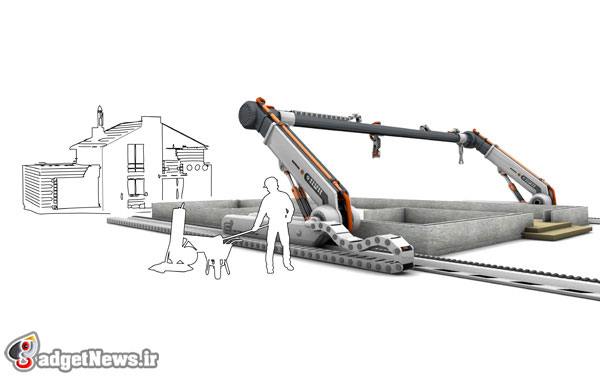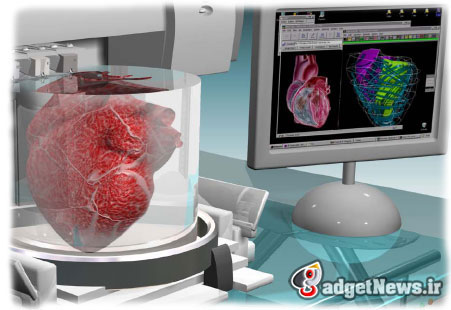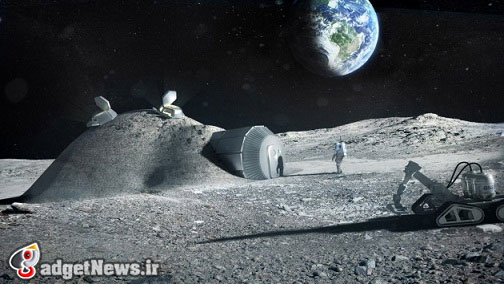
30 سال از اولین باری که چاک هال اولین پرینتر 3 بعدی دنیا را اختراع کرد میگذرد. از آنزمان تا به امروز ایده پرینت اجسام از تخیل به واقعیت تبدیل شده و دریچههای نوینی را از زمینههای علمی گرفته تا هنر به روی بشریت باز کرده است. در ادامه با ادامه اين خبر با گجت نيوز همراه باشيد .
شاید هنوز هم پرینت سه بعدی به جایی که باید نرسیده ، اما در طول این سه دهه، تکنولوژی در زمینه چاپ سه بعدی جهشهایی داشته است.
باور نکردن قطعی این فنآوری هنوز هم آسانتر از باور کردنش به نظر میرسد، زیرا هنوز در مقدار کم، با قیمت گران و با کارایی کمتری نسبت به دیگر سازههای معمولی ساخته میشود. در مقاله زیر با ما باشید تا با 5 شی که بزودی توانایی چاپ سه بعدی آنها را بدست میآوریم آشنا شوید.
خانه

یک محقق در دانشگاه کالیفرنیای جنوبی ادعا کرده است که یک خانه بزرگ را با چاپگر سه بعدی که میتواند در 24 ساعت 2500 متر مربع را بسازد ایجاد کرده است.
این چاپگر مفهمومی از بتون به عنوان ماده ساخت استفاده کرده و با فن آوری ساخت لایه ای به نام “Contour Crafting”، خانه را با اطمینان از اینکه مجهز به تمام کانالهای لازم برای برق، تهویه هوا و لوله کشی است میسازد.
محققان لابراتوار رسانه دانشگاه ام آی تی مدتهای مدیدی است که به ساخت خانه از طریق چاپ سه بعدی اندیشیدهاند. پرینتر مدل میتواند یک تانکر با بازوهای مکانیکی باشد که در عرض چند ساعت به ساخت فنداسیون خانه بپردازد.
درخت

دو محقق ناسا در حال کار بر روی ایجاد روشی هستند که از طریق آن(فن آوری زیست چاپ سه بعدی ) بتوانند درخت بسازند. طبق ادعای این گروه محقق، میتوان سلولها را برای دفع مواد غیر زنده مثل چوب کاشت. بجای استفاده از پلاستیک، چاپگر سه بعدی به چاپ سلولهای زنده با الگویی معین روی ژلاتینی پرداخته که به سلولها سیگنالی برای آغاز دفع چوب میفرستند. ناسا برای این تیم بودجهای 100000 دلاری در نظر گرفته تا به آنها در عملی شدنش کمک کند.
با اینکار فضانوردان بدون نیاز به حمل درختان به فضا، میتوانند در سیارههای دیگر هم درخت بسازند. ناسا امیدوار است که اولین درخت چاپ شده در سال 2014 کامل شود.
گوشت و چرم

روزی را تصور کنید که به راحتی و بدون فکر کردن به لحظه درد آور کشته شدن یک حیوان استیک بخورید یا یک دست لباس چرم شیک بپوشید.Modern Meadow پیشرو در تولید محصولات سه بعدی وابسته به گاو است. بر طبق اطلاعات کمپانی، بدست آوردن چرم و گوشت از گاو، هم گران است و هم برای بسیاری غیر قابل تحمل.
این فرایند با استفاده از مواد سلولی جوهر زیستی انجام میشود. سال گذشته این کمپانی هزینه هنگفت 350000 دلاری را صرف چاپ یک نوار استیک کرد. هدفی که شاید به طور کامل به آن نرسید و موفق نبود.
ارگانهای پیچیده

چاپ سه بعدی اعضا میتواند آنهایی را که در فهرست انتظار دریافت عضو هستند خوشحال کند. اما بحث الان درباره چاپ عضوی مثل قلب است. مهندسان زیستی موسسه نوآوری قلب و عروق در دانشگاه لوئیزویل باور دارند که قادرند در ده سال آینده قلب جایگزین بسازند. این تیم در حال حاضر موفق به ساخت عروق کرونر و برخی از کوچکترین رگهای خونی قلب شده است.

مشخص است که اگر این مهندسین نتوانند به این عضوها زندگی ببخشند، ساخت آنها هیچ فایدهای نخواهد داشت. در سال 2013، دانشمندان یک کبد کوچک ساختند که تنها 5 روز زنده ماند، اما این موفقیت باعث شد که یک کمپانی فعال در زیست چاپ قول ساخت یک کبد تمام اندازه را در امسال بدهد.
دانشمندان پیش از این موفق به چاپ سلولهای بنیادی جنینی شده بودند، پس احتمالا گام بعدی باید تنها وادار کردن این سلولها به رشد باشد.
پایگاه فضایی در ماه

شاید این سازه تخیلیترین سازه در این فهرست باشد. یک آژانس فضایی اروپایی در حال بررسی این فرضیه است که فضانوردان بتوانند پایگاه مستقر در ماه خود را داشته باشند. با نبود پلاستیک، احتمالا پرینتر های سه بعدی از خاک ماه برای ساخت استفاده خواهند کرد.
محققین ESA در حال حاضر یک ساختمان 1.5 تونی و ساخته شده از خاک ماه را چپ سه بعدی کردهاند. نتیجه محکم و مقاوم است اما به دلیل سبک وزنی توخالی درست شده است. البته این سازه روی زمین ساخته شده و فعلا در ماه چنین اتفاقی نیفتاده است.
منبع : readwrite
5 Crazy Things We May Soon Be Able To 3D Print
In five to 10 more years, 3D printing capabilities could be incredible.
What’s cooler than the stuff you can 3D print today? The things that 3D printers are almost, but not quite yet, capable of printing someday soon.
3D Printing has come a long way since inventor Charles Hull first prototyped it more than 30 years ago. One of Hull’s first ever builds was a shot-glass sized plastic cup, and even that took days to design and print. Today, scientists and researchers are dwarfing early models both in the sheer size and wealth of materials that they’re prototyping for future prints.
Here are some of the latest advances in 3D printing that are right on the horizon. You can’t print any of them yet, but optimistic technologists think we’ll have all of them within a decade.
Houses
A researcher at University of Southern California claims to have designed an enormous 3D printer that could build a 2,500 square foot home in just 24 hours.
The conceptual printer uses concrete as its medium of choice to replicate computer programs of houses. It uses a layered fabrication technology called “Contour Crafting” in order to make sure that houses are built with all the necessary conduits for electrical, air conditioning, and plumbing.
A house-building machine could have far-reaching implications for low income housing, disaster recovery, and home prototyping, but none of that can happen until the machine exists. Until then, you can watch videos of a prototype contour crafting printer in action.
Researchers at the MIT Media Lab in the mediated matter group have long envisioned building houses with 3D printing. The model would be the skeleton of a house using a tanker truck with a robotic arm that could print the foundation of the house in hours.
Trees
Well, technically, it’s 3D-printed wood. Two NASA researchers are developing a way to “grow” trees using 3D bioprinting technology.
According to the research team, cells can be cultured to excrete non-living material, like wood. Instead of using plastic, the 3D printer will print living cells in a specific pattern into a gel which will signal the cells to begin excreting wood. The team received $100,000 in funding from NASA’s Innovative Advanced Concept Program to make it happen.
This way, astronauts could bring wood to space without actually having to carry along heavy trees from Earth. NASA expects to have the first 3D printed tree complete some time in 2014.
Meat And Leather
Imagine being able to chow down on a steak or wear a fashionable leather jacket and boots—minus that whole slaughtering animals thing.
Modern Meadow is at the forefront of 3D printed bovine byproducts. According to the company, obtaining our meat and leather from cows is just as costly as it is unsustainable. Add to that the number of people hungry for slaughter-free beef and there might actually be a high demand for synthetic meat.
The process is completed by using cellular matter know as bio-ink to build meat products.
In a summary to the Department of Agriculture, Modern Meadow makes its case:
In this technology, conveniently prepared multicellular aggregates (the bio-ink particles) are delivered into a biocompatible support structure according to a design template (compatible with the shape of the desired biological construct) by a computer-controlled delivery device (the bio-printer).
Last year, the company received a six-figure grant to print a one-inch strip of steak, a goal which, judging by the lack of tasty headlines, they haven’t quite reached. But that’s not to say they don’t have the research and brains behind their claim to still make it work.
Complex Organs
Not that ears, bones, and skin aren’t complicated in their own ways. But new advances on the horizon of 3D bio-printing may make organ donor waiting lists a thing of the past.
The next challenge? A human heart. Bioengineers at the Cardiovascular Innovation Institute at the University of Louisville think we’ll be able to create custom heart replacements in a decade. The team has already bio-printed a coronary artery and some of the heart’s smallest blood vessels. They’re hoping to soon print a functioning heart in one go.
Of course, 3D printed organs are no good if engineers are unable to keep them alive. In 2013, scientists bio-printed a tiny liver, but it only stayed alive for about five days. Still, that small success has at least one medical bio-printing company promising to make the first full-size fully functioning liver sometime this year.
If printing complicated organs from scratch turns out to be a dud, why not leave that work to the human body? Scientists can already 3D print embryonic stem cells, so the next step might just be triggering them to get growing.
A Moon Base
This is the most ambitious and most blue sky build on the list. But wouldn’t it be awesome, the European Space Agency is hypothesizing, if astronauts could print their own moon base?
In the absence of plastic, 3D printers on the moon might use lunar soil to create the building blocks of a moon habitat. Researchers at the ESA have already 3D printed 1.5 tonne building block made out of synthetic lunar soil. The results are sturdy but hollow (for lightness) block that astronauts can assemble themselves.
Of course, these experiments are still happening here on Earth. The real test of 3D printing’s power will occur once the ESA launches this technology into space.
 گجت نیوز آخرین اخبار تکنولوژی، علم و خودرو
گجت نیوز آخرین اخبار تکنولوژی، علم و خودرو 





